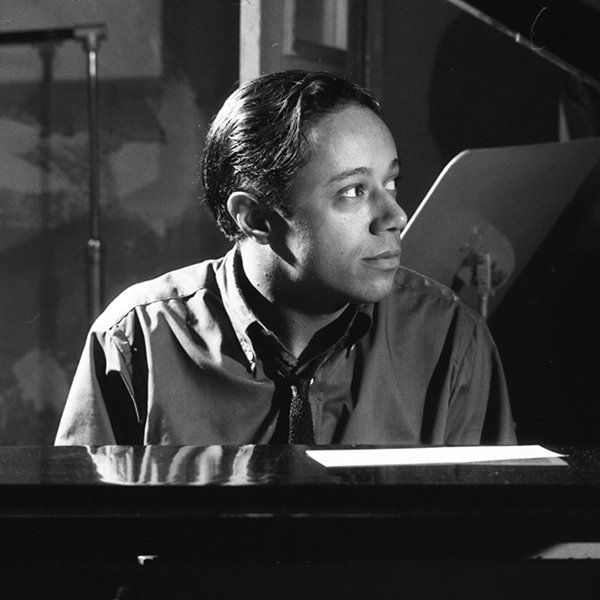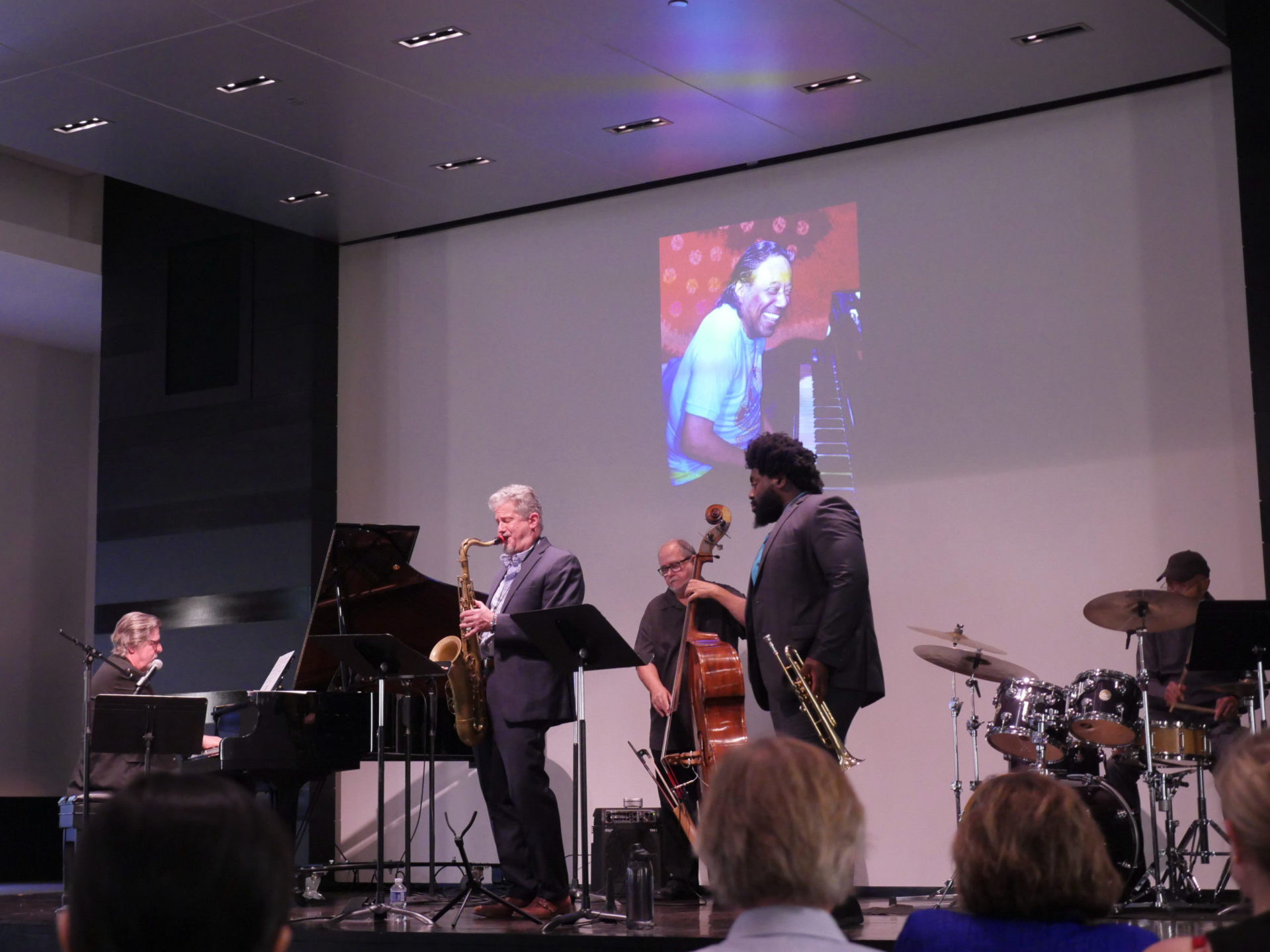Nashville Jazz Workshop Presents Jazz on the Move
The Jazz World’s Precious Metal: Horace Silver
The five jazz pros were mined from differing ores—cool jazz, smooth jazz, bebop, rock, blues—but together they gradually produced a fine alloy that honored the legacy of Horace Silver, pianist extraordinaire. Silver’s legacy as one of the cofounders of hard bop, a style that melds the dissonance and rhythmic energy of bebop with the softer genres of blues, gospel, and soul, was well represented Sunday afternoon at a 3 pm program collaboratively hosted by the Nashville Jazz Workshop and the Frist Art Museum. This is part of NJW’s Jazz on the Move series that places jazz in a variety of venues around Nashville.
Born in Connecticut, Horace Silver, who died in June 2014, first heard jazz at a county festival when he was ten years old. He was mesmerized by the sharp-dressing, tight-playing Jimmie Lunceford Band and decided that’s what he wanted to do. After some training, he moved to New York where he frequently played at Birdland, one of New York’s most significant monuments to jazz. As part of the “put-together” bands—local musicians who warmed up the audience for the headliners—he was able to hear musicians like Art Tatum and Teddy Wilson, and play with musicians like Art Blakey, Stan Getz, and Bud Powell. Through a record-collecting girlfriend, he was introduced to Thelonious Monk and became a lifelong fan.

Unusually, once signed with Blue Note Records, he stayed with them for nearly thirty years. In an interview for Minneapolis Public Radio, he attributed this longevity and his success as a performing musician to the fact that he didn’t drink, smoke, do drugs, or show up late. Later, he left to start his own label, Silveto Records for music that was growing more spiritual, more metaphysical, incorporating singers. He kept his Emerald label for the more typical jazz instrumentals that had established his reputation.
The Frist’s well-attended event, a fusion of concert, bits of history, and verbal program notes, educated and entertained in nearly equal measure. From the piano, Pat Coil provided valuable little nuggets of history to an enthusiastic audience, bringing the backstory of the works to life with relaxed humor. One missing element was more information on how each work was representative of Silver’s style. But some of that came through Coil’s playing style for each piece.
The band consisted of a rhythm section with Coil, an MTSU professor who has played with artists as diverse as Natalie Cole, Barry Manilow, Travis Tritt, and Woody Herman, on piano; Roger Spencer, co-founder of NJW and adjunct at Vanderbilt’s Blair School of Music who has done stints with Les Brown and His Band of Renown, Rosemary Clooney, and Tony Bennett, on bass; and guest artist Chester Thompson, a veteran of fusion having played with the famed Weather Report and Genesis, on drums.
On horns, trumpeter Emmanuel Echem, a Belmont graduate who has performed or recorded with Kirk Franklin, Boyz II Men, LeAnn Rimes, and one of my favorite lesser-known bands, Dumpstaphunk, which features members of the famed Neville musical family out of New Orleans; and Don Aliquo on tenor sax, another MTSU professor that has performed with Gary Burton and Roger Humphries. His 2019 album The Innocence of Spring was nominated as one of the Top 10 jazz recordings on National Public Radio.
Initially, the band members kept to their individual origins. In “Nica’s Dream,” for example, Thompson, the drummer was a bit heavy on the snares, perhaps part of his rock history, while Coil and Aliquo, piano and tenor sax, repped cool jazz, à la Dave Brubeck and Paul Desmond, respectively. Trumpeter Echem showed some of the rough edges sometimes found in Miles Davis, while Spencer, the bass player stayed somewhere in the middle. But there were hints of better to come.
In “No Smoking,” Spencer showed a more assertive walking bass, to complement Coil’s well-placed splashes of chords, while Thompson had a nice way with syncopation on the ride cymbal. In “Gregory is Here,” a song written for the birth of Silver’s son, Coil set up the Cuban son clave rhythms into a sweet groove, reminding me of the Buena Vista Social Club, a group of elderly Cuban musicians whose careers were revitalized by American guitarist Ry Cooder. In this laidback work, the trumpet and sax finally began to blend.

Following Coil’s lovely solo intro with its sense of Debussy harmonies and Silver melodies, Thompson’s nice brushwork and Spencer’s casually strolling bass blended with Aliquo’s cello-like timbre in Silver’s bluesy “Peace.” When Echem joined, his trumpet timbre matched the rest and here, these talented individual professionals became a band. Once they found the right formula of their constituent parts, the mix was stable for the rest of the show, moving as a unit from style to style.
For example, “Nutville” was next, a high-energy, hardcore bebop piece. Coil said he didn’t know where the name came from but to me, it clearly has some of the drive and unexpected humor of Charlie Parker and Dizzy Gillespie’s “Salt Peanuts.” But in Silver’s signature style, there’s a fusion of close dissonant harmonies for the horns and Latin groove, in this case the Brazilian trecillo rhythm. It was also the best arrangement of the day. Starting together, they drop down to a trio of sax, bass, and drums, then everyone reenters before a driving vamp leads to the one extended drum solo of the day.
It was worth the wait. Thompson took us on a world tour beginning with some spicy work on the crash cymbal, slowing down and softening into a delicate, almost Asian sound formed from the metallic sounds of drum rims and cymbals, before building back up with indigenous sounds of South America emphasizing the tom-toms, and bringing it on home to American jazz.
The final work “Song for my Father” is, as Coil noted, one of Silver’s best-known and most frequently covered. Like Monk’s “Round Midnight” and Gershwin’s “I Got Rhythm,” several backing tracks of it are available on YouTube for aspiring players who want to learn iconic works. Its basic pattern was apparently borrowed for Steely Dan’s “Ricky Don’t Lose that Number,” increasing its renown. Sunday’s rendition proved to be a nice fusion of cool jazz harmonies, Brazilian samba rhythms, and standard pop timing. As Silver once said, “Why make it difficult for listeners to hear?”
In keeping with Silver’s ethos, this gorgeous arrangement was definitely easy on the ears. It was dedicated to his father, an immigrant from Cape Verde (a set of islands off the coast of northwest Africa) and his father’s love of a variety of musical styles, including the Portuguese folk songs he sang to his son. The much-welcomed extended bass solo gave plenty of time to relax into the mood. The trumpet eased right in, the sax’s lovely tone balanced chill with driving chromatic transitions, while the drum did his best hi-hat work, dropping in a few light bebop accents, as the pianist maintained a languid tropical style with just a taste of boogie-woogie, one of the styles that influenced the star of the show, Horace Silver. May he rest in the peace of his music.



